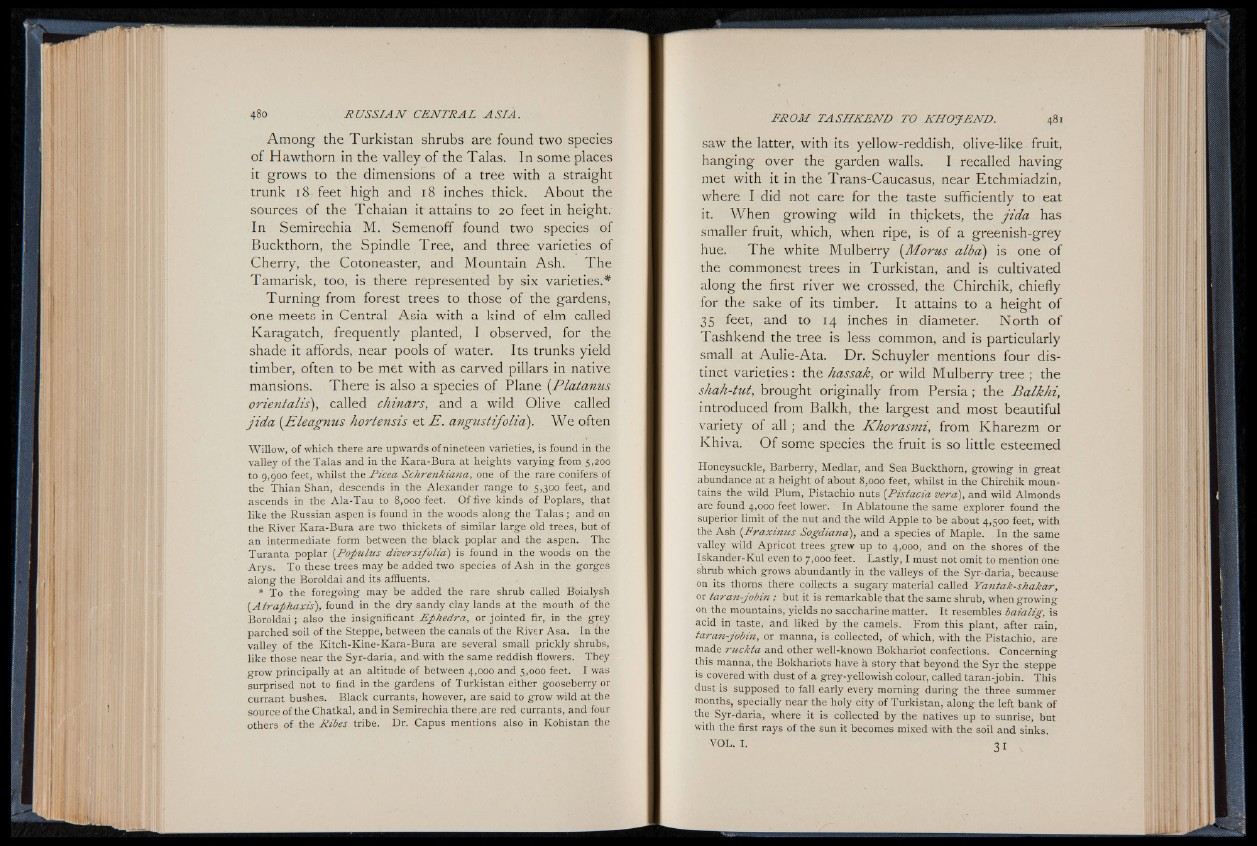
Among the Turkistan shrubs are found two species
of Hawthorn in the valley of the Talas. In some places
it grows to the dimensions of a tree with a straight
trunk 18 feet high and 18 inches thick. About the
sources of the Tchaian it attains to 20 feet in height.
In Semirechia M. Semenoff found two species of
Buckthorn, the Spindle Tree, and three varieties of
Cherry, the Cotoneaster, and Mountain Ash. The
Tamarisk, too, is there represented by six varieties.*
Turning from forest trees to those of the gardens,
one meets in Central Asia with a kind of elm called
Karagatch, frequently planted, I observed, for the
shade it affords, near pools of water. Its trunks yield
timber, often to be met with as carved pillars in native
mansions. There is also a species of Plane (Platanus
orientalis), called chinars, and a wild Olive called
jid a (Eleagnus hortensis et E . angustifolia). We often
Willow, of which there are upwards of nineteen varieties, is found in the
valley of the Talas and in the Kara-Bura at heights varying from 5,200
to 9,900 feet, whilst the Picea Sch.renkia.na, one of the rare conifers of
the Thian Shan, descends in the Alexander range to 5,300 feet, and
ascends in the Ala-Tau to 8,000 feet. Of five kinds of Poplars, that
like the Russian aspen is found in the woods along the Talas ; and on
the River Kara-Bura are two thickets of similar large old trees, but of
an intermediate form between the black poplar and the aspen. The
Turanta poplar (P o ju lu s diversifolia) is found in the woods on the
Arys. To these trees may be added two species of Ash in the gorges
along the Boroldai and its affluents.
* To the foregoing may be added the rare shrub called Boialysh
(Atrajhaxis), found in the dry sandy clay lands at the mouth of the
Boroldai; also the insignificant Ephedra, or jointed fir, in the grey
parched soil of the Steppe, between the canals of the River Asa. In the
valley of the Kitch-Kine-Kara-Bura are several small prickly shrubs,
like those near the Syr-daria, and with the same reddish flowers. They
grow principally at an altitude of between 4,000 and 5,000 feet. I was
surprised not to find in the gardens of Turkistan either gooseberry or
currant bushes. Black currants, however, are said to grow wild at the
source o f the Chatkal, and in Semirechia there,are red currants, and four
others of the Ribes tribe. Dr. Capus mentions also in Kohistan the
saw the latter, with its yellow-reddish, olive-like fruit,
hanging over the garden walls. I recalled having
met with it in the Trans-Caucasus, near Etchmiadzin,
where I did not care for the taste sufficiently to eat
it. When growing wild in thickets, the jid a has
smaller fruit, which, when ripe, is of a greenish-grey
hue. The white Mulberry (Morus alba) is one of
the commonest trees in Turkistan, and is cultivated
along the first river we crossed, the Chirchik, chiefly
for the sake of its timber. It attains to a height of
35 feet, and to 14 inches in diameter. North of
Tashkend the tree is less common, and is particularly
small at Aulie-Ata. Dr. Schuyler mentions four distinct
varieties: the hassak, or wild Mulberry tree ; the
shah-tut, brought originally from Persia; the B a lkh i,
introduced from Balkh, the largest and most beautiful
variety of all ; and the Khorasmi, from Kharezm or
Khiva. O f some species the fruit is so little esteemed
Honeysuckle, Barberry, Medlar, and Sea Buckthorn, growing in great
abundance at a height of about 8,000 feet, whilst in the Chirchik mountains
the wild Plum, Pistachio nuts (Pistacia vera), and wild Almonds
are found 4,000 feet lower. In Ablatoune the same explorer found the
superior limit of the nut and the wild Apple to be about 4,500 feet, with
the Ash (Fraxinus Sogdiana), and a species of Maple. In the same
valley wild Apricot trees grew up to 4,000, and on the shores of the
Iskander-Kul even to 7,000 feet. Lastly, I must not omit to mention one
shrub which grows abundantly in the valleys of the Syr-daria, because
on its thorns there collects a sugary material called Yantak-shakar,
or taran-jobin; but it is remarkable that the same shrub, when growing
on the mountains, yields no saccharine matter. It resembles baialig, is
acid in taste, and liked by the camels. From this plant, after rain,
taran-jobin, or manna, is collected, of which, with the Pistachio, are
made ruckta and other well-known Bokhariot confections. Concerning
this manna, the Bokhariots have a story that beyond the Syr the steppe
is covered with dust of a grey-yellowish colour, called taran-jobin. This
dust is supposed to fall early every morning during the three summer
months, specially near the holy city of Turkistan, along the left bank of
the Syr-daria, where it is collected by the natives up to sunrise, but
with the first rays of the sun it becomes mixed with the soil and sinks.
VOL. I. 3 1 v